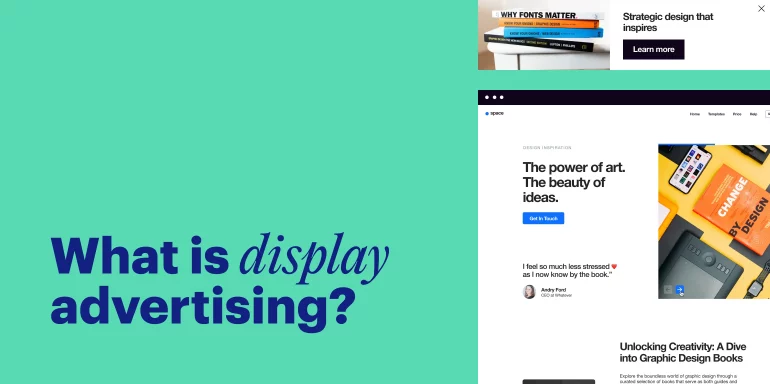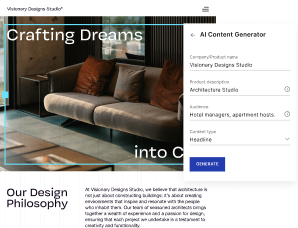Display advertising has come a long way since October 27, 1994, when the first banner ad promoting AT&T appeared on HotWired:

Here’s what a typical display ad looks like today:

However, it’s not just the appearance of display ads that has changed—the frequency with which users see display advertising has exponentially increased over the years.
A recent experiment by The Drum suggests that an average user living in the US sees around 93 display ads per day.
That’s overwhelming, to say the least, and probably the reason why, according to recent data, 530 million people use Adblock software on their mobile devices, and 290 million people use Adblock software on their desktop browsers. These numbers have seen a significant increase since 2011:
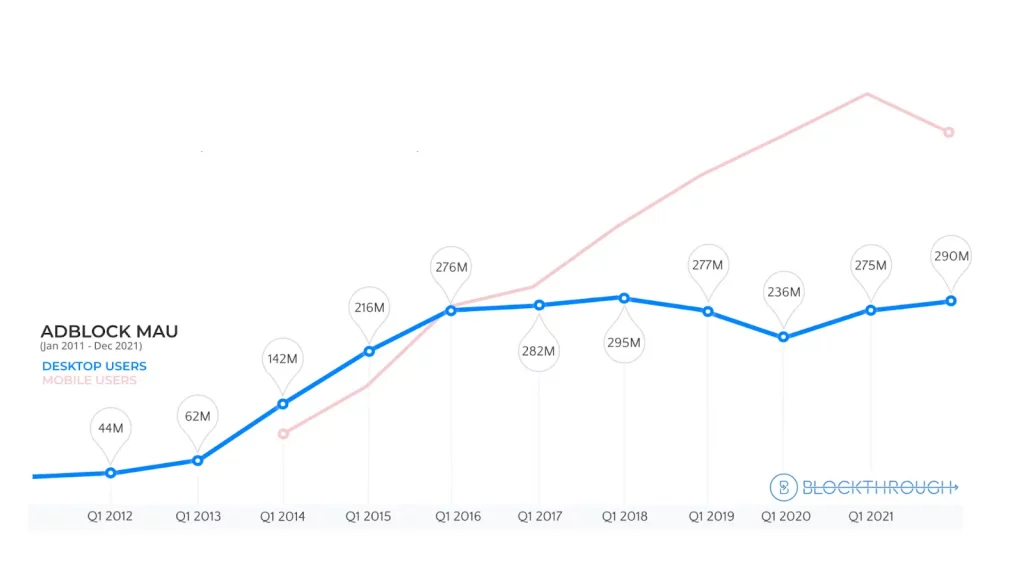
Some reasons why users opt to use Adblock software include the threat of malware, interruption, slow website loading time, too many ads on too many web pages, and tracking by unknown parties.
Does this mean there’s no point in creating display advertising campaigns because even if your ad gets through to users, they’ll likely have banner blindness and won’t react to it?
Well, quite the contrary. When you create display ads that target the right audience with the right message, you can significantly increase brand awareness and your ROAS.
So, what exactly is display advertising, and how do you create ads that work? Let’s find out.
What is display advertising?
Display advertising is a type of online advertising that features text, images, animation, videos, and other creative elements to promote a product or service. Placed on third-party websites, social media platforms, or within various apps, display ads urge consumers to click through to a landing page and take action (subscribe to a newsletter, make a purchase, etc.)
Display ad costs differ, but what makes them cost-effective is how flexible they are. Unlike traditional ads, where you can’t tweak visuals, calls to action (CTAs), or messages once the campaign starts running, display advertising is dynamic, meaning advertisers can adjust things on the go. This flexibility helps brands optimize their campaigns and get the most out of their budget.
Digital advertising market share
Research suggests that the global display advertising market will reach 292.7 billion U.S. dollars by 2026.
Several factors are driving the display ad market growth, including:
- High demand for digital advertising
- Better internet access and connectivity
- The increasing use of mobile devices
- Growing ad spend by brands
- Increased automation of advertising platforms
Why marketers prefer display advertising over search ads
Marketers lean towards choosing display advertising over search ads for various reasons, and the decision largely depends on the objectives of a marketing campaign.
Here are some reasons why you, as a marketer, might prioritize display advertising:Marketers lean towards choosing display advertising over search ads for various reasons, and the decision largely depends on the objectives of a marketing campaign. Here are some reasons why you, as a marketer, might prioritize display advertising:
-
1. Brand visibility and awareness: Display ads have proven to be more efficient for elevating brand visibility, allowing you to showcase a brand, product, or service to a broader audience, even if users are not actively searching for related terms.
Third-party cookies contribute to boosting brand visibility, as advertisers have been using them to better understand consumer behavior and preferences by tracking user online activities across various websites. However, starting Q1 2024, Google Chrome and other browsers will begin phasing out third-party cookies in order to better protect user privacy, but display ads will still work, just a bit differently.
2. Visual appeal: Display ads seize attention with striking graphics and elements, which is especially beneficial for products or services that thrive on a visually impactful presentation.
3. Robust targeting options: With a wide range of targeting options, display ads allow you to hone in on specific demographics, interests, and behaviors. This precision targeting is invaluable for campaigns demanding a nuanced approach to connecting with a particular audience.
4. Content promotion: In content marketing, display advertising is excellent for drawing attention to valuable content, serving as one the best ways to promote blog posts, articles, and other content pieces.
5. Rich media formats: Display ads are a canvas for rich media formats featuring interactive elements, animations, and videos. This flexibility empowers marketers to craft dynamic and immersive ad experiences, particularly effective for specific products or services.
6. Retargeting options: With retargeting ad campaigns, you can reignite the interest of potential customers who’ve previously visited your website but didn’t make a purchase and nudge them toward conversions.>
7. Top-of-the-funnel engagement: Display and search advertising can work as complementary tools within a digital marketing strategy. While search ads capture users actively searching for specific products or information, display ads are more suitable for introducing the brand to potential customers.
It’s important to note that the choice between display and search ads often depends on the specific campaign objectives, target audience, and the nature of the products or services promoted. Many successful digital marketing strategies combine display and search advertising to maximize reach and effectiveness.
Why is display advertising important?
Imagine this: someone has just learned about your products or services. Now, think of a strategically placed display ad as a friendly reminder nudging them to consider making a purchase.
In fact, display ads are capable of so much more than that:
- Display advertising caters to the people who already know about you and lets you reach out to new audiences who have yet to discover what you offer.
- Display advertising offers a targeted approach by giving you a lot of choices in who sees your ads. It’s not about reaching everyone. It’s about reaching the right people. With display advertising, you’re in the driver’s seat, deciding who sees your ads and who doesn’t.
- Display advertising lets you choose who sees your ads based on topics, interests, where the ads appear, the context, people’s demographics, or specific details about your custom audience. You can tailor your targeting to align with your marketing goals, reaching those who fit your ideal audience or reconnecting with past customers and visitors.
By taking advantage of the diverse targeting options in display advertising, you increase the chances of reaching people eager to purchase with a higher likelihood of turning those prospects into customers and boosting conversion rates.
Programmatic display advertising
Programmatic display advertising, also known as “programmatic marketing” or “programmatic media buying,” is the method of purchasing ad space through software and leveraging intricate algorithms for targeted ad delivery.
Now, let’s clarify the difference between programmatic and display ads. In simple terms, “programmatic” refers to the way you buy ads, while “display” refers to the format of how ads look. The key difference lies in the purchasing process and the ability to buy ads across various platforms.
Display ads are often associated with placing ads within a specific ad network, like the Google Display Network. Programmatic advertising takes it up a notch, as it operates across multiple platforms, including supply-side platforms (SSPs) and demand-side platforms (DSPs), allowing advertisers to buy ad inventory across an open network of platforms.
With programmatic display ads, marketers have control over critical aspects such as audience targeting, bidding strategy, budget, creative content, and ad placements. It’s like navigating the advertising waves precisely, ensuring your message reaches the right audience in a suitable format across diverse platforms.
Types of display ads
You can advertise the following types of display ads:
1. Banner ads
Banner ads are the most common type of display ads that appear at the top, bottom, or sides of a webpage. They are static images designed to grab attention and encourage clicks.

2. Interstitial ads
Interstitial ads show up as web pages before you go to the webpage or app you wanted to access in the first place. In the example below, you can see how it looks before you open a webpage on a desktop and mobile:
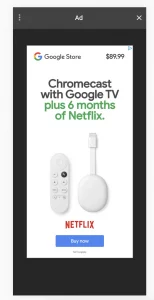
3. Rich media ads
These ads incorporate video, audio, animations, and fillable or clickable elements, such as lead forms, to serve the purpose of lead generation. There are three main types of rich media ads:
- In-page ads show up on a specific ad placement within the webpage
- In-stream ads are video ads that appear before (pre-roll), during (mid-roll), or after (post-roll) video content
- Out-of-page ads are usually initiated by user behavior, for instance, pop-up and expandable ads

4. Native ads
Native advertising refers to a form of advertising that attempts to match the surrounding content on a website to make the message more easily consumable by the users of that website. Native ads appear in-feed and are non-disruptive, like suggested posts on Facebook or promoted posts on Twitter.
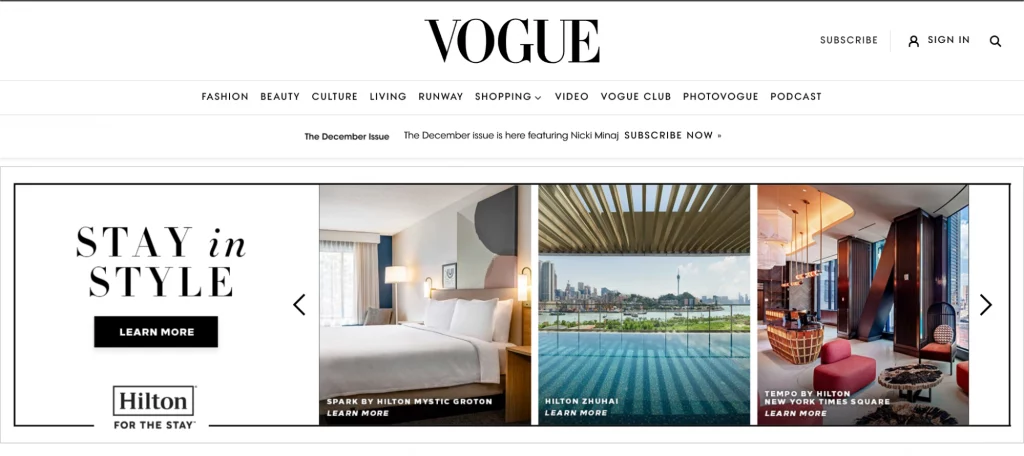

5. Video ads
Video ads use moving images and sound to convey a message. They can roll before, during, or after online video content, within social media feeds, or on websites. Video ads are effective for conveying stories and capturing attention.
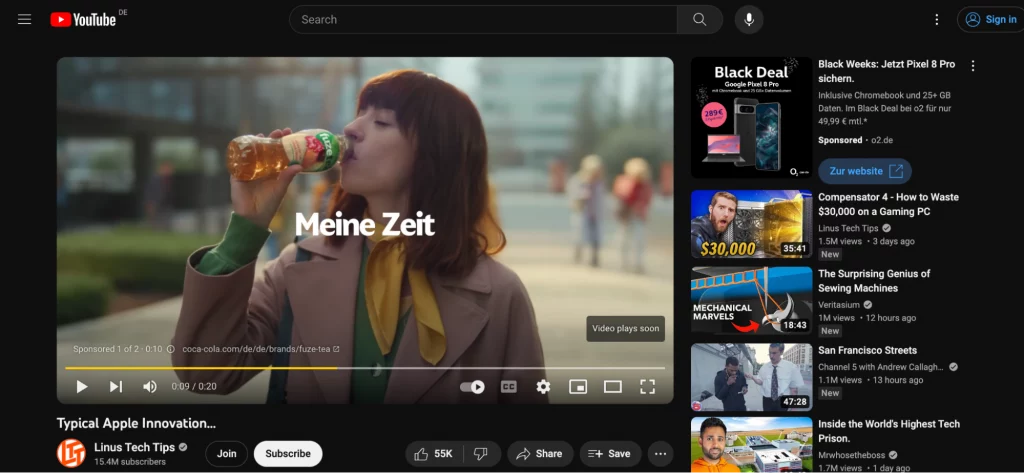
6. Social media ads
Social media ads appear on social media platforms like Facebook, Instagram, Linkedin, Twitter, and Pinterest. They can take various forms, including image ads, carousel ads, slideshow ads, and video ads. As a part of social media advertising strategy, this type of advertising offers extensive targeting capabilities, allowing you to reach potential customers based on their geographic, demographic, psychographic, and behavioral characteristics/traits.

7. Search ads
Search engine advertising is a type of advertising that appears at the top or bottom of search engine results pages. Search ads are typically text-based and triggered by specific keywords. You can bid on keywords to have your ads displayed when users search for relevant terms.
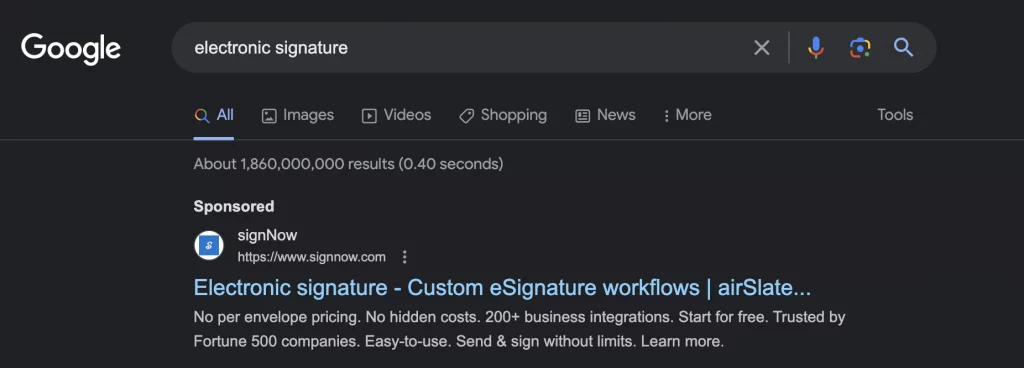
8. Affiliate marketing banners
These banners are part of affiliate marketing programs where businesses pay affiliates a commission for driving traffic or sales through the affiliate’s marketing efforts. Affiliate marketing banners often contain unique tracking links to monitor conversions.


Why you should include display ads in your marketing campaigns
As mentioned earlier, display ads offer a quicker return on ad spend (ROAS) as they appear on publisher websites immediately after a campaign launch. This is in contrast to SEO, where establishing authority is necessary before appearing in search results.
Running both short-term and long-term ad campaigns enables your business to optimize conversions over an extended period. Once your marketing materials are part of an ad network, targeting and reach become seamless. Take the Google Display Network, for instance—it has the capacity to display your ads on numerous websites visited by your target audience, especially if you carefully selected the right keywords during the campaign launch.
Moreover, display advertising networks offer tools for precise monitoring, refining, and scaling of your campaigns. Using advertising platforms, marketers can identify which assets generate the most impressions, clicks, and conversions—valuable insights that may enhance other marketing efforts as well.
What’s the difference between display ads and banner ads?
Display advertising is an umbrella term representing the big family of digital ads that comes in all shapes and sizes, including banner ads, video ads, pop-up ads, and many more.
Banner ads are rectangular ads you often see at the top, bottom, or sides of a webpage. Today, we usually refer to these as leaderboard ads.
Sometimes, people use the terms “banner ads” and “display ads” interchangeably when discussing display marketing. This could be because, back in the day, display ads were often banners at the top of a website.
To sum up, all banner ads are display ads, but not every display ad is a banner ad.
Why are display ads essential for remarketing?
Remarketing or retargeting allows you to keep your brand in front of your potential customers after they have left your website without performing an action—persuading them to reconsider your offer when they need it.
Remarketing involves showing ads to prospects based on their behavior on your web pages to guide them through your marketing funnel. The process is enabled by cookie-based pixels that track your prospects’ internet browsing behavior after they abandon your website.
Remarketing display ads help call back lost visitors by showing them relevant ads to products/services they showed interest in while on your webpage.
The buyer journey is no longer linear. In fact, it looks like this:
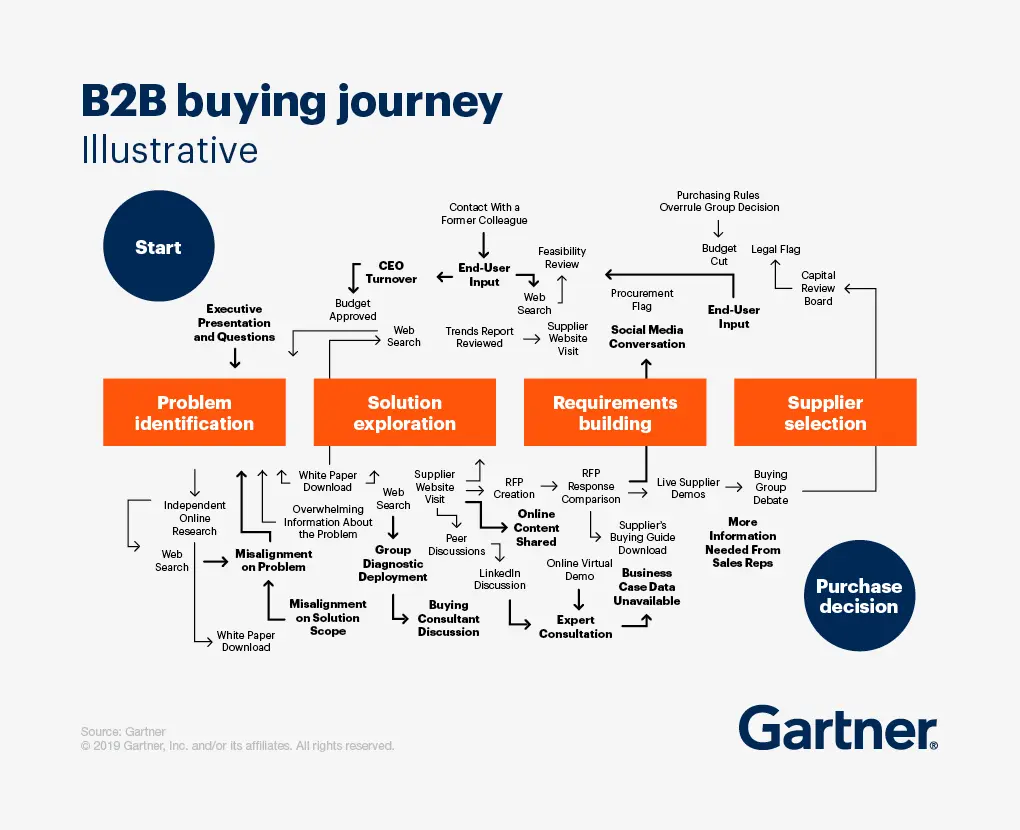
Remarketing display ads help you highlight your value proposition for your target audiences who have steered away from your website—persuading them to revisit your offer when they believe they need it.
There are two types of remarketing campaigns:
- Pixel-based remarketing works with the help of a JavaScript code that’s placed on your website or landing page. After the pixel is attached, whenever a visitor comes to your website or landing page, the pixel drops an anonymous browser cookie that helps you track their online activities and show relevant display ads at the right time. Take note: starting Q1 2024, Google Chrome and other browsers will begin phasing out third-party cookies in order to better protect user privacy. Google will propose new functionality for cookies to continue supporting legitimate use cases while preserving user privacy.
- List-based remarketing shows ads to your existing customers to retarget specific ads at them.
Your remarketing display ad campaigns should have the following two goals depending on where the user is in their buying cycle/journey:
- Awareness: The campaigns are meant for the top-of-the-funnel users—visitors who have had little interaction with your brand. Awareness campaigns inform visitors about your product features and other announcements. You can run awareness campaigns as a forerunner for your conversion campaigns.
- Conversion: The campaigns are meant for the middle-of-the-funnel users—visitors who are more familiar with your brand and its products or services. They could sign up for a free trial, download an ebook, or watch a webinar but still haven’t bought your product or service. So, you want them to click on a relevant display ad, direct them to a dedicated landing page, and convince them to do so.
Whether you choose to run awareness campaigns or conversion campaigns, the key to creating remarketing display ads that work lies with audience segmentation.
Segment your audience based on the following:
- Behavior: There are two types of behaviors a visitor can showcase when they’re on your website – not Interested (the visitors spend less than a few seconds on your website, don’t go to any other page on your site, and immediately exit), and Interested (the visitors browse through the website content, maybe even click through to other pages like the resources page, pricing page, or the about us section). Serve remarketing ads to Interested visitors with high intent.
- Time: Time segmentation involves taking care of three things:
- The time duration between the visitor’s website visit and when you show them the first display ad
- The frequency with which visitors see ads
- The time duration between the visitor’s first visit to the website and the time when they stop seeing remarketing ads
- Existing customers: Show your display ads to customers who aren’t that active on your platform. The new feature update might convince them to become more active.
Depending on your advertising platform, your remarketing display ads can have multiple formats. However, the components of an optimized remarketing ad essentially remain the same.
Optimized remarketing display ads
Optimizing remarketing display ads involves creating ads that have the following components:
- A persuasive headline: The ad headline should be relevant to the visitors’ experience on your website and must be written to make it stand out.
- Relevant, visually appealing media: Your display ad media should be relevant to the offer presented in your ad copy and must look visually appealing. Be sure to use the branding colors you know the visitor saw on your website to make an instant visual connection.
- A relevant CTA button: Design the CTA button in a contrasting color and add relevant copy.
- Actionable copy: Display ads have limited characters; ad copy that gets to the point immediately and incentivizes visitors to click will likely get you more clicks.
This remarketing display ad has a persuasive discount offer and a call to action:

If you want your target audience to continue the journey with your brand beyond the remarketing ad click, always connect your ads to relevant landing pages. How you optimize the landing page for your display ads and what components all post-display ad click landing pages must have is what we’ll discuss in the next section.
Why connecting display ads to relevant landing pages is important
Optimizing your display ads with the right components gets you an ad click. The prospect of reaching your target audience by clicking your ads is exciting, it’s true. However, the customer journey doesn’t end with the ad click; it is just the beginning.
To ensure that users still want to avail of your offer after clicking the ad, you must connect all your display ads with relevant landing pages.
What is a landing page?
A landing page is exactly what its name suggests—it’s the experience that occurs immediately after a user clicks an ad. You can optimize the landing page by connecting all your ads to landing pages that have the following two attributes:
1. Message match
Message match refers to the process of matching the content of an ad to the content of a landing page to make the user aware that they have landed on a relevant page.
When you create an ad and landing page that maintains a message match, you reassure the user that the page they’ve come to is the one the ad CTA button promised to bring them to.
The display ad and epam landing page maintain a message match. The ad copy talks about future-forward IT services, and the landing page follows through with the same message:

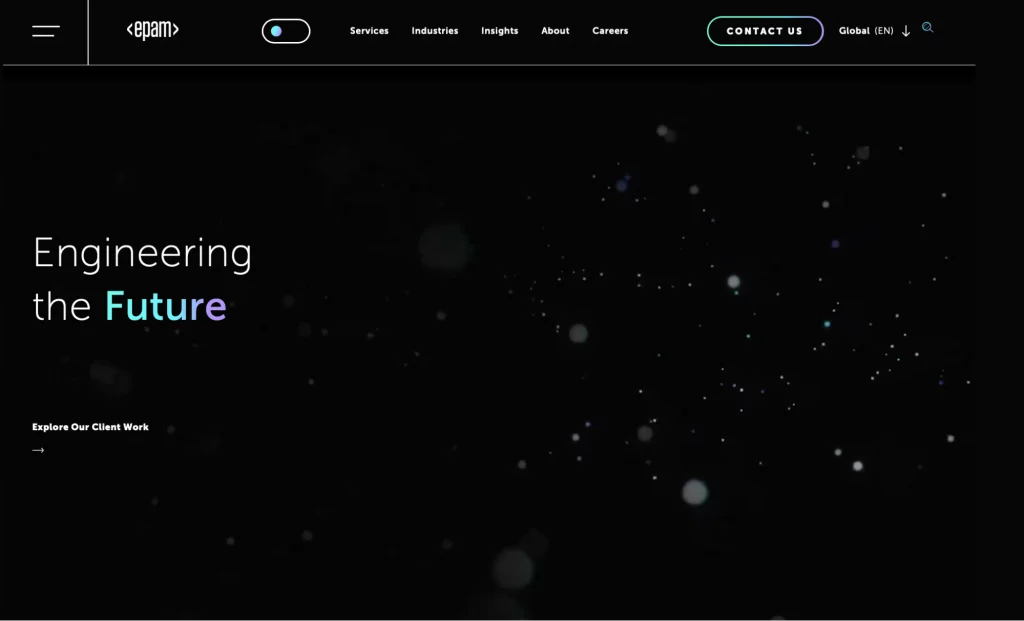
In addition to message match, maintaining a conversion ratio of 1:1 is also very important for an optimized landing page.
1:1 conversion ratio
Conversion ratio refers to the number of places to click on a webpage compared to the number of conversion goals presented on the page. A proper landing page is standalone, separated from your main website’s navigation. The purpose of this page is to promote a single offer, so it should always maintain a 1:1 conversion ratio.
The only clickable link on an optimized landing page is the CTA button. Suppose your landing page has other off-page navigation links. In that case, you are essentially going against the very definition of a landing page, which minimizes your chances of getting visitors to fulfill the conversion goal.
The Active Campaign display ad and landing page maintain message match:
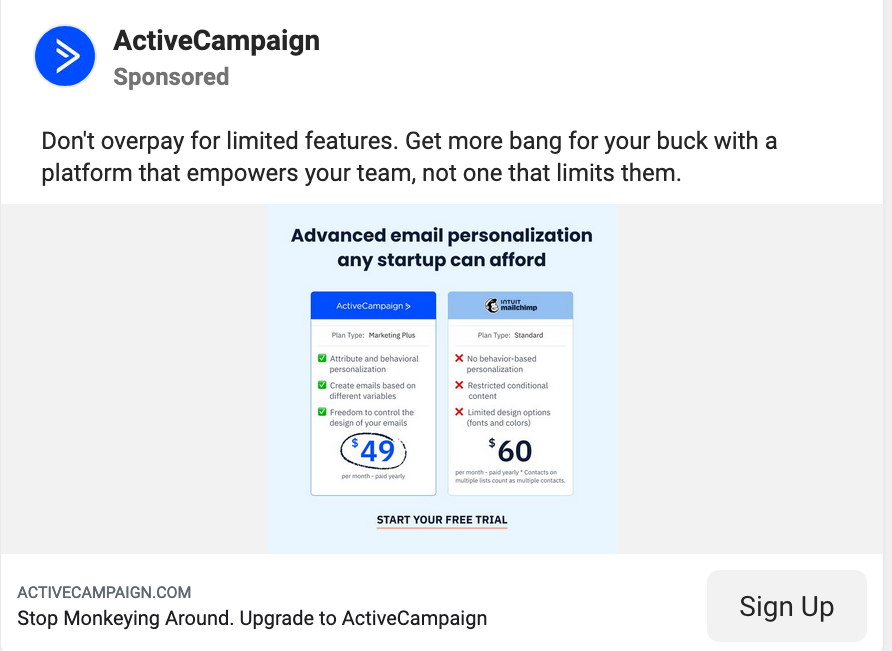
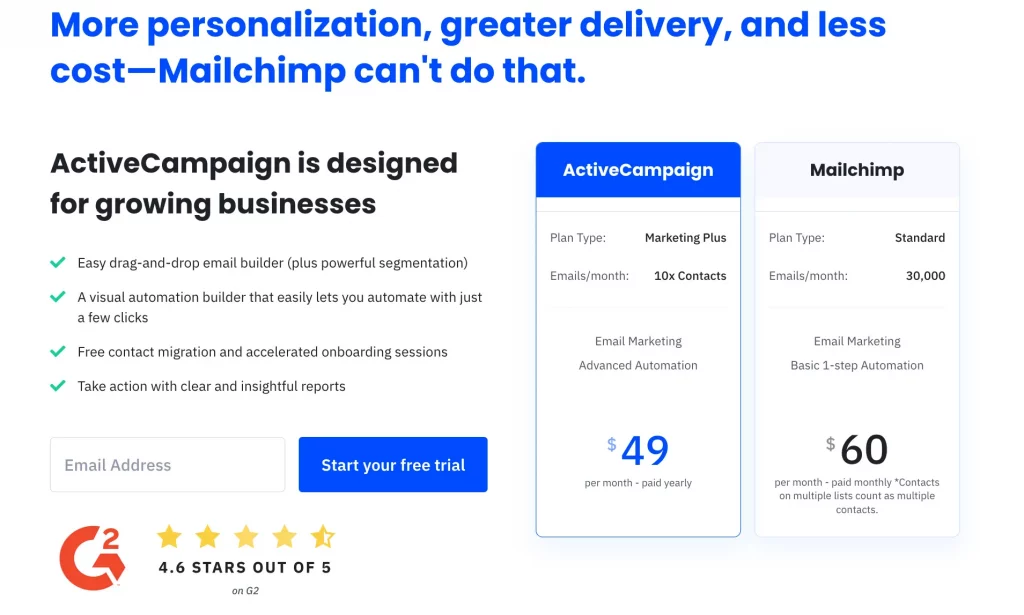
Pair all your display ads with relevant, optimized landing pages to convince visitors to continue their journey with your brand beyond the ad click.
Display advertising allows you to use images and other rich media types to create ads that have the visual appeal to attract new customers and call back potential customers who have lost their way. When you create optimized display ads and connect them to relevant landing pages, you increase the chances of getting an ad click and a CTA button click.
Create optimized landing pages for your display ads today with Instapage.
Sign up for the Instapage 14-day free trial and use the industry’s most sophisticated landing page platform with advanced testing and analytics capabilities.

Try the world's most advanced landing page platform with a risk-free trial.
